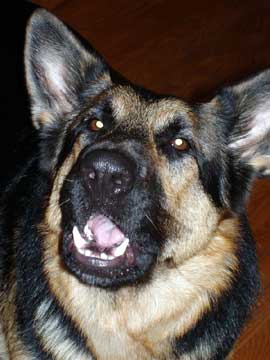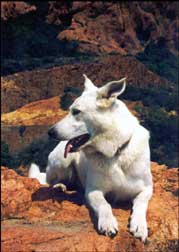Handling dog aggression -
Recognizing and preventing it
Handling dog aggression is very important. Dogs are instinctively aggressive creatures. Let me explain - in the wild, aggressive behaviors came in very handy for our canine friends. Dogs needed aggression to hunt, to defend themselves from other creatures, and to defend resources such as food, a place to sleep, and a mate.
As a result of selective breeding over the centuries this trait has minimized and refined significantly, but there’s just no getting around it: dogs are physically capable of inflicting serious harm (just look at those teeth!) because that’s how they’ve survived and evolved.
And Mother Nature is smart – it’s hard to counteract the power of instinct!
Don't worry, however, concerning handling dog aggression. That doesn’t mean that we, as dog lovers and owners, are entirely helpless when it comes to handling our dogs.
There’s a lot that we can do in handling dog aggression to prevent aggression from rearing its ugly head in the first place – and even if prevention hasn’t been possible (for whatever reason), there are still steps that we can take to recognize and deal with it efficiently.

- First Let's Discuss Different Aggression Types -
Concerning handling dog aggression, there are different types of canine aggression. Two of the most common types you'll see are:
• Aggression towards strangers
• Aggression towards family members You may be wondering why we're bothering categorizing this stuff in the first place: after all, aggression is aggression, right? And we want to work it out NOW, not waste time with the details – right?
No - not quite. These two different types of aggression stem from very different causes, and require different types of treatment when handling dog aggression. Let's deal with the first type:
- Aggression towards any kind of stranger -
First of all, why does it happen?
There's one major reason why a dog doesn't like strange people: he's never had the chance to get used to them. Remember, your dog relies 100% on you to broaden his horizons for him: without being taken on lots of outings to see the world and realize for himself, through consistent and positive experiences, that the unknown doesn't necessarily equal bad news for him, how can he realistically be expected to relax in an unfamiliar situation?
What exactly is aggressive behavior towards strangers?
It's pretty easy to tell when a dogs anxious around strange people. He's jumpy and on the alert: either he can't sit still and is constantly fidgeting, leaping at the smallest sound, and pacing around barking and whining; or he's veerrrry still indeed, sitting rock-steady in one place, staring hard at the object of his suspicions (a visitor, the mailman, someone approaching him on the street while he's tied up outside a store.)
What can I do about this kind of aggression?
The process of getting your dog used to meeting the world and all the strange people (and animals) that it contains is called socialization. This is an incredibly important aspect of your dog’s upbringing: in fact, it’s pretty hard to overemphasize just how important it is to do this before handling dog aggression or having these problems crop up in the first place. Socializing your dog means exposing him from a young age (generally speaking, as soon as he’s had his vaccinations) to a wide variety of new experiences, new people, and new animals.
How does socialization prevent stranger aggression?
When you socialize your dog, you're getting him to learn through experience that new sights and sounds are fun, not scary.
It's not enough to expose an adult dog to a crowd of unfamiliar people and tell him to "Settle down, Roxy, it's OK" – he has to learn that it's OK for himself. And he needs to do it from puppyhood for the lesson to sink in.
The more types of people and animals he meets (babies, toddlers, teenagers, old people, people on bicycles, men, women, people wearing uniforms, people of all different colors, people wearing motorcycle helmets, people carrying umbrellas, people in cars, etc.) in a fun and relaxed context, the more at ease and happy – and safe around strangers - he'll be in general.
How can I socialize my dog so that he doesn't develop a fear of strangers?
This is sssoooooooo important! Socializing your dog is pretty easy to do – it's more of a general effort than a specific training regimen. Do this, and do this well, and you'll probably never have to worry about handling dog aggression in the first place.
First of all, you should take him to puppy preschool. This is a generic term for a series of easy group-training classes for puppies (often performed at the vet clinic, which has the additional benefit of teaching your dog positive associations with the vet!).
In a puppy preschool class, about ten or so puppy owners get together with a qualified trainer (often there'll be at least two trainers present – the more there are, the better, since it means you get more one-on-one time with a professional) and start teaching their puppies the basic obedience commands: sit, stay, and so on.
Even though the obedience work is very helpful and is a great way to start your puppy on the road to being a trustworthy adult dog, really the best part of puppy preschool is the play sessions: several times throughout the class, the puppies are encouraged to run around off-leash and play amongst themselves.
This is an ideal environment for them to learn good social skills: there's a whole bunch of unfamiliar dogs present (which teaches them how to interact with strange dogs), there's a whole bunch of unfamiliar people present (which teaches them that new faces are nothing to be afraid of), and the environment is safe and controlled (there's at least one certified trainer present to make sure that things don't get out of hand).
Socialization doesn’t just stop with puppy preschool, though. It’s an ongoing effort throughout the life of your puppy and dog: he needs to be taken to a whole bunch of new places and environments.
Remember not to overwhelm him: start off slow, and build up his tolerance gradually. Now let's talk about the next kind of aggression well discuss in this article about handling dog aggression:

- Aggressive behavior towards family members -
When handling dog aggression it is important to know that there are two common reasons why a dog is aggressive towards members of his own human family:
1) He’s trying to defend something he thinks of as his from a perceived threat (you).
This is known as resource guarding, and though it may sound innocuous, there’s actually a lot more going on here than your dog simply trying to keep his kibble to himself.
2) He’s not comfortable with the treatment/handling he’s getting from you or other members of the family.
Next, resource guarding - what is resource guarding?
Resource guarding is pretty common among dogs. The term refers to overly-possessive behavior on behalf of your dog: for instance, snarling at you if you approach him when he's eating, or giving you "the eye" (a flinty-eyed, direct stare) if you reach your hand out to take a toy away from him.
All dogs can be possessive from time to time – it's in their natures. Sometimes they're possessive over things with no conceivable value: inedible trash, balled up pieces of paper or tissue, old socks. More frequently, however, resource-guarding becomes an issue over items with a very real and understandable value: food and toys.
Why does it happen in the first place?
It all boils down to the issue of dominance. Let me take a moment to explain this concept: dogs are pack animals. This means that they're used to a very structured environment: in a dog-pack, each individual animal is ranked in a hierarchy of position and power (or "dominance") in relation to every other animal. Each animal is aware of the rank of every other animal, which means he knows specifically how to act in any given situation (whether to back down, whether to push the issue, whether to muscle in or not on somebody else's turf, etc etc).
To your dog, the family environment is no different to the dog-pack environment. Your dog has ranked each member of the family, and has his own perception of where he ranks in that environment as well.
This is where it gets interesting: if your dog perceives himself as higher up on the social totem-pole than other family members, he's going to get cheeky. If he's really got an overinflated sense of his own importance, he'll start to act aggressively.
Why? Because dominance and aggression are the exclusive rights of a superior-ranked animal. No underdog would ever show aggression or act dominantly to a higher-ranked animal (the consequences would be dire, and he knows it!) Whenever handling dog aggression it is very important to know what causes it in the first place to be able to treat it successfully.
Resource guarding is a classic example of dominant behavior: only a higher-ranked dog (a “dominant” dog) would act aggressively in defense of resources.
To put it plainly: if it was clear to your dog that he is not, in fact, the leader of the family, he’d never even dream of trying to prevent you from taking his food or toys – because a lower-ranking dog (him) will always go along with what the higher-ranking dogs (you and your family) say.
So, what should I do about it?
The best treatment for handling dog aggression, dominant behavior when handling dog aggression is consistent, frequent obedience work, which will underline your authority over your dog. Just two fifteen-minute sessions a day will make it perfectly clear to your dog that you're the boss, and that it pays to do what you say.
You can make this fact clear to him by rewarding him (with treats and lavish praise) for obeying a command, and isolating him (putting him in "time-out", either outside the house or in a room by himself) for misbehavior.
• If you're not entirely confident doing this yourself, you may wish to consider enlisting the assistance of a qualified dog-trainer.
• Brush up on your understanding of canine psychology and communication, so that you understand what he's trying to say – this will help you to nip any dominant behaviors in the bud, and to communicate your own authority more effectively
• Train regularly: keep obedience sessions short and productive (no more than fifteen minutes – maybe two or three of these per day).
• The instant he starts to show signs of stress, stop immediately and let him relax. Try to make the whole thing into a game: give him lots of praise, pats, and treats.
• Take things slowly. Don’t push it too far: if you get nervous, stop.
• Remember when dealing or working with handling dog aggression that dogs show aggression for a reason: they're warning you to back off, or else!Return from handling dog aggression to training your GSD
America is a large friendly dog in a small room. Every time it wags it's tail it knocks over a chair." - Arnold Toynbee
Sign up for promotions, news, discounts, and the chance to win prizes for you and your German Shepherd
